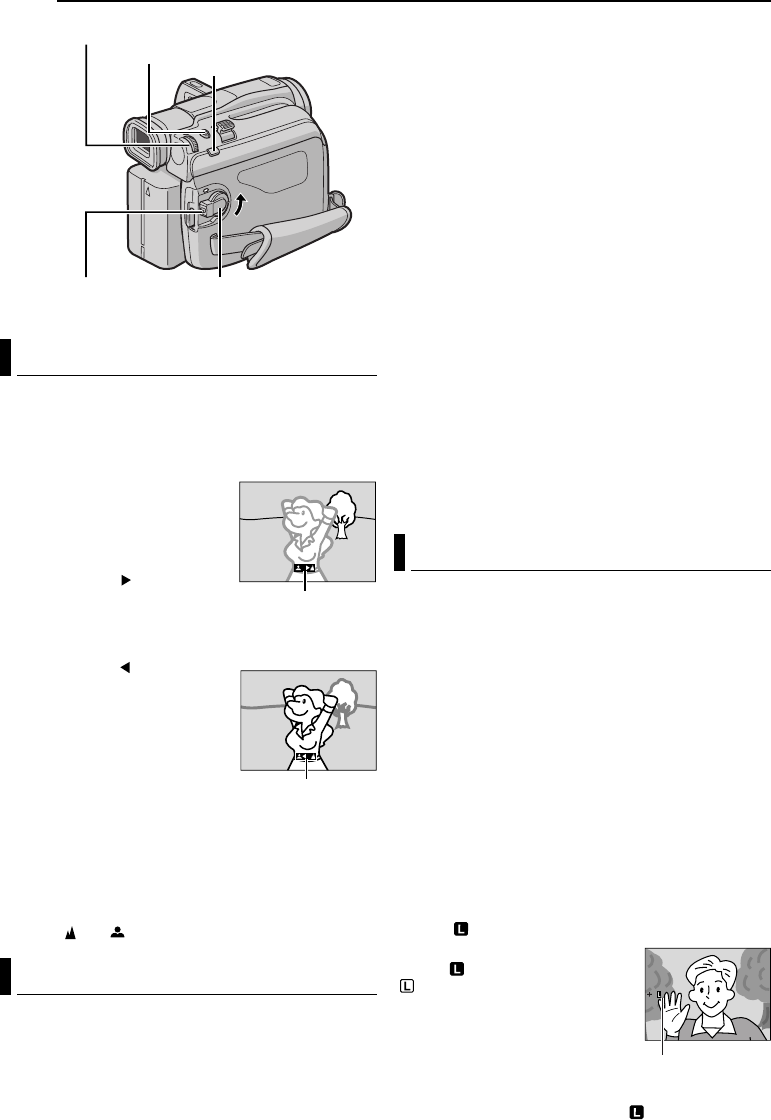
FEATURES FOR RECORDING
32 EN
MasterPage: Left
NOTE:
If you are using the viewfinder, you should already have
performed “Viewfinder Adjustment” (੬ pg. 9).
1 Set the Power Switch to “M”
while pressing down the Lock
Button located on the switch.
2 Press FOCUS. The manual
focus indicator appears.
3 To focus on a further subject,
rotate the MMENU/VOL. Wheel
towards “+”. The “” indicator
appears and blinks.
To focus on a nearer subject,
rotate the MMENU/VOL. Wheel
towards “–”. The “” indicator
appears and blinks.
To reset to Auto Focus
Press FOCUS twice or set the
Power Switch to “A”.
If FOCUS is pressed once, the
camcorder will enter the focus
adjustment mode again.
NOTES:
● Be sure to focus the lens in the maximum telephoto position
when you use the Manual Focus mode. If you focus in on a
subject in the wide-angle position, sharply focused images
cannot be obtained when zoomed up because the depth-
of-field is reduced at longer focal lengths.
● When the focus level cannot be adjusted any further or
closer, “” or “” will blink.
Manual exposure control is recommended in the
following situations:
● When shooting using reverse lighting or when the
background is too bright.
● When shooting on a reflective natural background such as
at the beach or when skiing.
● When the background is overly dark or the subject is bright.
1 Set the Power Switch to “M” while pressing down the
Lock Button located on the switch.
2 Open the LCD monitor fully. (੬ pg. 12)
3 Press the MMENU/VOL. Wheel in. The Menu Screen
appears.
4 Rotate the MMENU/VOL. Wheel to select
“p (EXPOSURE)”, and press it.
5 Rotate the MMENU/VOL. Wheel to select “MANUAL”,
and press it.
● The exposure control indicator appears.
6 To brighten the image, rotate the MMENU/VOL.
Wheel towards “+”. To darken the image, rotate the
MMENU/VOL. Wheel towards “–”. (maximum ±6)
● +3 exposure has the same effect as the backlight
compensation. (੬ pg. 33)
● –3 exposure has the same effect as when “r” is set to
“SPOTLIGHT”. (੬ pg. 31)
7 Press the MMENU/VOL. Wheel in. Exposure
adjustment is complete.
To return to automatic exposure control
Select “AUTO” in step 5. Or, set the Power Switch to “A”.
NOTES:
● You cannot use the manual exposure control at the same
time when “r” is set to “SPOTLIGHT” or “SNOW”
(੬ pg. 30), or with the backlight compensation. (੬ pg. 33)
● If the adjustment does not cause any visible change in
brightness, set “GAIN UP” to “AUTO”. (੬ pg. 25, 26)
Like the pupil of the human eye, the iris contracts in well-
lit environments to keep too much light from entering,
and dilates in dim environments to allow in more light.
Use this function in the following situations:
● When shooting a moving subject.
● When the distance to the subject changes (so its size in the
LCD monitor or the viewfinder changes), such as when the
subject is backing away.
● When shooting on a reflective natural background such as
at the beach or when skiing.
● When shooting objects under a spotlight.
● When zooming.
When the subject is close, keep the iris locked. Even
when the subject moves away from you, the image will
not darken or brighten.
Before doing the following, perform steps 1 – 5 in
“Exposure Control” (੬ pg. 32).
6 Adjust zoom so that the subject fills the LCD monitor
or the viewfinder, then press and hold the MMENU/VOL.
Wheel for over 2 seconds. The exposure control indicator
and the “” indication appear.
7 Press the MMENU/VOL. Wheel
in. The “” indication changes to
“” and the iris is locked.
To return to automatic iris
control
Rotate the MMENU/VOL. Wheel
to select “AUTO”, then press it in
step 5. Or, set the Power Switch to
“A”.
● The exposure control indicator and “” disappear.
Manual Focus
Exposure Control
Power Switch
SNAPSHOT
Lock Button
FOCUS
MMENU/VOL.
Manual focus indicator
While focusing on a
further subject
Manual focus indicator
While focusing on a
nearer subject
Iris Lock
3
Iris Lock Indicator
GR-D94US.book Page 32 Monday, November 17, 2003 2:12 PM


















